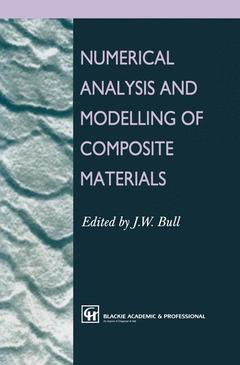Description
Numerical Analysis and Modelling of Composite Materials, 1996
Coordinator: Bull J.W.
Language: English
Subject for Numerical Analysis and Modelling of Composite Materials:
Keywords
composite; composite material; fatigue; masonry; modeling; simulation
Publication date: 11-2012
441 p. · 15.5x23.5 cm · Paperback
441 p. · 15.5x23.5 cm · Paperback
Description
/li>Contents
/li>
Composite materials are increasingly used in many applications because they offer the engineer a range of advantages over traditional materials. They are often used in situations where a specified level of performance is required, but where the cost of testing the materials under the extremes of those specifications is very high. In order to solve this problem, engineers are turning to computer Modelling to evaluate the materials under the range of conditions they are likely to encounter. Many of these analyses are carried out in isolation, and yet the evaluation of a range of composites can be carried out using the same basic principles.
In this new book the editor has brought together an international panel of authors, each of whom is working on the analysis and Modelling of composite materials. The overage of the book is deliberately wide; to illustrate that similar principles and methods can be used to model and evaluate a wide range of materials. It is also hoped that, by bringing together this range of topics, the insight gained in the study of one composite can be recognized and utilized in the study of others.
Professional engineers involved in the specification and testing of composite material structures will find this book an invaluable resource in the course of their work. It will also be of interest to those industrial and academic engineers involved in the design, development, manufacture and applications of composite materials.
In this new book the editor has brought together an international panel of authors, each of whom is working on the analysis and Modelling of composite materials. The overage of the book is deliberately wide; to illustrate that similar principles and methods can be used to model and evaluate a wide range of materials. It is also hoped that, by bringing together this range of topics, the insight gained in the study of one composite can be recognized and utilized in the study of others.
Professional engineers involved in the specification and testing of composite material structures will find this book an invaluable resource in the course of their work. It will also be of interest to those industrial and academic engineers involved in the design, development, manufacture and applications of composite materials.
1 Analysis of composite rotor blades.- 1.1 Introduction.- 1.2 Deformation.- 1.3 Strains.- 1.4 Constitutive relations.- 1.5 Equations of equilibrium and boundary conditions.- 1.6 Reduction of the case of thin-walled cross-sections.- 1.7 Loads.- 1.8 Analytic solution.- 1.9 Numerical schemes.- 1.10 Summary.- References.- 2 Analysis and modelling of damage and repair of composite materials in aerospace.- 2.1 Introduction.- 2.2 Damage types.- 2.3 Finding the damage.- 2.4 Damage modelling and analysis.- 2.5 Repair, design and analysis.- 2.6 Conclusions.- References.- 3 Ritz type solution for the free vibrations of fibre-reinforced cylindrical shells.- 3.1 Introduction.- 3.2 Basic equations for cylindrical shells.- 3.3 Solution procedure.- 3.4 Numerical examples.- 3.5 Concluding remarks.- References.- 4 Numerical analysis and modeling of the creep behavior of composite multilayered cylindrical pressure vessels.- 4.1 Introduction.- 4.2 An optimum design for the composite multilayered cylindrical pressure vessels.- 4.3 Creep relaxation in composite multilayered pressure vessels.- 4.4.3 Finite element results.- 4.5 Numerical examples.- 4.6 Summary.- References.- Nomenclature.- 5 Stresses in composite panels with openings.- 5.1 Introduction.- 5.2 Finite element modelling and analysis.- 5.3 Stresses around holes.- 5.4 Global-local analysis.- 5.5 Stresses in panel with two elliptical holes.- 5.6 Design considerations.- 5.7 Concluding remarks.- References.- Nomenclature.- 6 The numerical analysis and modelling of repaired runways following chemical explosive crater formation.- 6.1 Background.- 6.2 Introduction.- 6.3 Crater prediction using characteristic parameters.- 6.4 Crater life expectancy.- 6.5 Crater modelling using PAFEC-FE software.- 6.6 Finite element model.- 6.7 Finite element results.- 6.8 Discussions.- 6.9 Conclusions.- Acknowledgements.- References.- 7 Numerical analysis and modelling of the damage and softening of brick masonry.- 7.1 Introduction.- 7.2 The problem to be solved.- 7.3 Numerical implementation.- 7.4 Numerical applications.- 7.5 Conclusion.- References.- 8 Numerical simulation of the impact resistance of composite structures.- 8.1 Introduction.- 8.2 Material modeling.- 8.3 Composite constitutive material models.- 8.4 Finite element mesh discretization of composites.- 8.5 Analysis tools.- 8.6 Industrial and research applications.- 8.7 Car crash investigation.- 8.8 Conclusion.- References.- 9 Numerical modeling of damage, property degradation and life prediction in fatigue of composite laminates.- 9.1 Introduction.- 9.2 Microlevel damage and stiffness reduction.- 9.3 A lamina approach to stiffness reduction.- 9.4 Stiffness reduction during fatigue.- 9.5 Cumulated nonelastic strain.- 9.6 Cumulative damage models.- 9.7 Fatigue life prediction of laminates.- 9.8 Residual strength.- 9.9 Summary.- References.- 10 Modelling of stress transfer across the fibre — matrix interface.- 10.1 Introduction.- 10.2 Micromechanical measurement of fibre — matrix interface properties.- 10.3 Stress transfer in fibre pull-out test.- 10.4 Analysis of composites with compliant fibre coating.- 10.5 Concluding remarks.- Acknowledgements.- References.- Nomenclature.- Appendix A: Coefficients A1, A2, A3 and A4.- Appendix B: Coefficients C1, C2 and C3.- 11 Modeling of enhanced composite creep and plastic flow in temperature cycling.- 11.1 Introduction.- 11.2 Review of experimental observations.- 11.3 A simple model for composite thermal cycling plasticity.- 11.4 Important issues in modeling.- 11.5 Modeling approaches.- 11.6 Composite behavior maps— using models and experiments to assess behavior.- 11.7 Concluding remarks.- Acknowledgements.- References.- 12 Determination of interfacial properties and stresses in continuous fiber-reinforced ceramic composites by means of single-fiber indentation tests.- 12.1 Introduction.- 12.2 Review of experimental techniques.- 12.3 Indentation tests.- 12.4 Summary.- Acknowledgements.- References.- Nomenclature.- 13 Numerical modelling of woven fabric composite materials.- 13.1 Introduction.- 13.2 Plain weave fabric geometry.- 13.3 Two-dimensional WF composite stiffness model.- 13.4 Experimental investigation.- 13.5 Validation of analytical predictions.- 13.6 Parametric studies.- 13.7 Design of woven fabric composites.- 13.8 Conclusions.- Acknowledgements.- References.- Nomenclature.
© 2024 LAVOISIER S.A.S.



